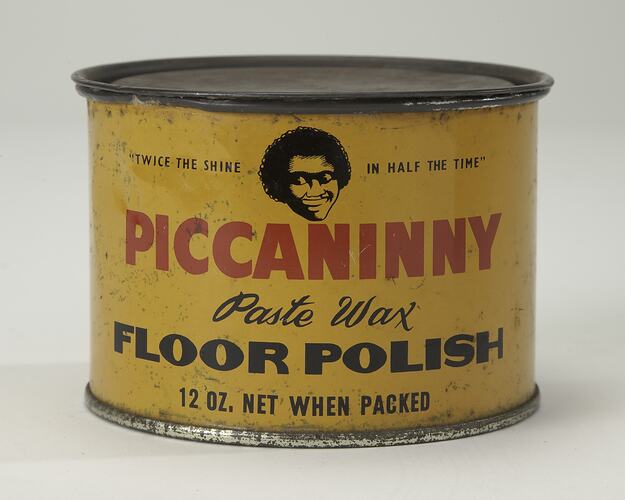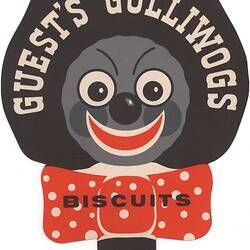Summary
Note: This object includes derogatory slurs, references to and depictions of First Nations people. Such words and sentiments are not condoned by Museums Victoria which considers them to be racist. Historical distance and context do not excuse or erase this fact.
Round yellow metal tin of Piccaninny Paste Wax Floor Polish manufactured by Piccaninny Manufacturing Co. Manly, NSW. The tin also includes a depiction of a person of either First Peoples (Australia) or African American background.
In the USA the term 'piccaninny', 'picanninny', 'picaninny' and other variations were used to describe mainly African American children in a derogatory and patronising way. Many of these images depict children with exaggerated features such as large red lips or large noses and depict them as natural buffoons. In Australia, the term picanninny was adopted in a similarly racist way to describe First Peoples children as inferior.
The company Piccaninny Manufacturing Co made a number of home maintenance products including wax polishes, detergents, perfumed soaps, floor sealers and plastic finishes through the 1920s to 1960s. Another example is: 'Piccaninny 'Pic-a-lyptus' antiseptic eucalyptus disinfectant', a bottle of which is held by the National Museum of Australia.
Physical Description
Round yellow metal tin of Piccaninny Paste Wax Floor Polish. Includes depiction of a person of either First Peoples (Australia) or African American background. Can is empty
Significance
The significance of the tin of Piccaninny Paste Wax Floor Polish lies primarily in its use of the word 'picanninny' and the depiction of a person of either First Peoples (Australia) or African American background on the tin to market a common domestic product. The ambiguity of the cultrual identity of the image is illustrative of the way racist imagery and terminology relating to people of colour were imported from the United States of America and adapted in Australia in this period, 1940s-1950s.
More Information
-
Collecting Areas
-
Acquisition Information
Purchase
-
Manufacturer
Piccaninny Manufacturing Company, Manly, Greater Sydney, New South Wales, Australia, 1940s-1950s
-
Inscriptions
Text on Front: 'TWICE THE SHINE IN HALF THE TIME' / PICCANINNY / Paste Wax / FLOOR POLISH / 12 OZ NET WHEN PACKED
-
Brand Names
-
Classification
-
Category
-
Discipline
-
Type of item
-
Overall Dimensions
106 mm (Width), 73 mm (Height), 106 mm (Outside Diameter)
-
Keywords
Aboriginal Depictions, Cleaning Products, Floor Maintenance, Racial Identity, Racism, Cultural Stereotypes




